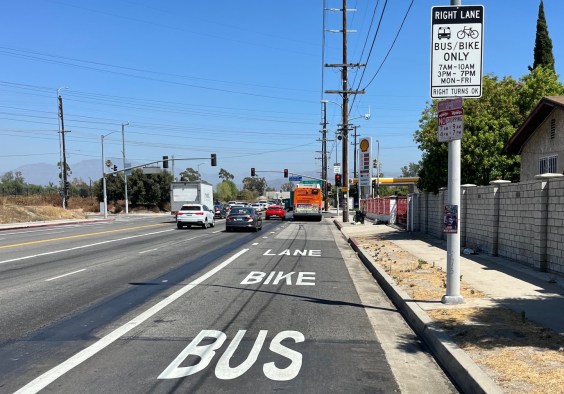
You may have heard that the National Football League's Rams are back in Los Angeles. The football is no doubt exciting, but the team's presence has also elevated Southern California conversations about parking, congestion, transit, and traffic.
Now through 2018, the Rams play home games at the Coliseum in Exposition Park, a stone's throw from the Metro Expo Line. In the future, the Rams will be playing at a new stadium under construction in Inglewood. The new stadium, expected to be completed by 2019, will be just over a mile from Metro's under-construction Crenshaw/LAX light rail line.
At the Rams first regular season home game, the Los Angeles Times reported parking prices surging well over $100. Rather than proclaiming parking doom, the paper interviewed parking expert Don Shoup, explained congestion pricing, and declared high prices to be "good news for mass transit backers." Metro's The Source reported that 26 percent of Rams attendees, 21,000 of the 80,000, took transit to the game. This is nearly quadruple transit's 7 percent share of L.A. County commute trips.
Though SBLA will offer some advice after the jump, first a couple of caveats:
- First, kudos to Metro for already doing a good job managing football crowds. During during pre-season games, Metro anticipated and managed serious crowds. Metro promoted transit to get to games, added signage, increased service on the Silver and Expo lines, and deployed staff to manage queues. According to a staff report [PDF], Metro transit carried 10,600 and 12,200 riders to the Rams preseason games, representing 13 and 20 percent of the attendance.
- Second, crowding expectations (and transit promotion) should be realistic. Fans should expect post-game transit to be packed, as it is around the world when big events let out. The goal is crowded trains and buses full of fans. Too many riders is a nice problem to have - it makes transit operate in a more efficient, more cost-effective way.
- Third, though these crowds are big, 20,000 is a drop in the bucket compared to 1.4 million weekday boardings systemwide. Football stadiums are important to serve, but they deliver up riders only a half-dozen or so Sunday afternoons a year. This tail should not wag the entire dog. Adding tons of service could mean tons of cost to Metro, given that transit rides are subsidized. It is important not to mortgage the system's daily ridership to chase a massive infrequent bolus. Nonetheless, like CicLAvia, gameday ridership can be a sort of gateway drug. Ride a bus to a Rams game today, then maybe ride a bus to work in the near future.
The Source asked for suggestions on what Metro can do differently. SBLA has some ideas below.
These are all relatively low cost programs, not infrastructure-intensive people-mover construction. None of these will carry tens of thousands of riders on day one, but expanding transportation options for game day can give people choices. Diverting a thousand fans here and a hundred fans there can take the edge off of the surge that occurs at the end of the game. In expanding options, it is important to benefit not only sports fans, but also provide ancillary benefits to the rest of Metro's riders, and to the neighborhoods impacted by car-choked streets around the stadium.
- Promote Walking - From the Coliseum, it is a two mile walk to L.A. Trade Tech Blue Line station, or a three mile walk to downtown L.A.'s 7th and Metro Red Line station. Those walks will not be for everyone, but if a couple hundred fans walk, then they are healthier, happier and the Expo Line peak crowding is reduced. Perhaps Metro and the Rams (perhaps partnering with public health community groups like L.A. Walks) could form some sort of Rams Walking Club. The club could operate a sort of walking school bus that would have regularly scheduled walks on pre-arranged routes. Perhaps there could be incentives, such as Rams Walking Club caps or T-shirts, or even some kind of promotional event along the way. It is probably too much to ask that a Rams player might make a guest appearance along the way, but perhaps walks could be led by a costumed mascot giving out Rams pennants, so the walk becomes a sort of moving pep rally for the team. Walk trips could be logged and entered into a drawing for prizes. Even if walkers did not walk the entire way, organized walk trips could open additional much-lower-cost car parking, such as at or near L.A. Trade Tech College.
- Extend downtown L.A. Metro Bike Share - Metro's current bike-share system already extends to L.A. Trade Tech, two miles from the Coliseum. It may be worthwhile to add a bike-share hub near the stadium. This would serve to connect Rams fans to downtown L.A. where they could connect with extensive rail and bus networks there. This could relieve eastbound Expo Line crowding, as riders could bike to the Blue, Red or even Gold lines. Perhaps there is a way to set up a staffed temporary bike-share drop-off/pick-up area to test the idea. This has been done in other cities, including in New York City during their open streets events.
- Bike Parking - In San Francisco, the SF Bicycle Coalition runs valet bike parking for Giants baseball home games. A similar arrangement could be made with an L.A. bicycle non-profit, such as the L.A. County Bicycle Coalition. Bikes would need a convenient parking area, but bike parking takes up a lot less space than car parking (a standard car parking space easily accomodates a dozen bikes) so the space would not need to be massive. If the rams are able to provide space for free, a nominal parking charge (say $1-2 per bike) could cover staffing. It might make sense to combine private bike parking area and the public bike-share docking mentioned above.
- Shuttle Buses - Similar to Hollywood Bowl shuttles, Metro's Dodger Stadium Express, and programs in other regions, Metro could operate fixed-route, potentially pre-paid shuttle service to the stadium. This service makes sense only if it does not require major subsidies. Better to improve existing rail and bus lines on game days than to create low ridership boutique new service.
- After-Game Activities at Exposition Park - One way to reduce peak traffic for transit (and for cars) is to get people to stick around after the game, and get home later. Metro and/or the Rams could work with Exposition Park museums to host special open house extended hours that coincide with game-end times. Perhaps there could be a rotating schedule between various museums to focus attendance to make it worthwhile. Alternately, there could be entertainment (a small concert, a mascot) for transit riders while they wait to board.
- Promote Taxi and Ride-Hail ride splitting - From comments, some transit riders looked at large lines for Expo and decided to take Lyft or Uber instead. Ride-hail cars contribute to traffic congestion around the stadium. To the extent that taxis and ride-hail companies can encourage fans to pile in and pool their rides and fill these vehicles, they will serve fans more efficiently and lessen their adverse impact on nearby streets.
While these recommendations apply to Rams games, they also apply to other sports and other stadiums, and even concerts and other events. Even though the Rams will be moving in 2019, Exposition Park will continue to host large-scale events, including, soon, Major League Soccer. Programs piloted now could be transposed to Inglewood in 2019.
What do you think readers? Would these programs work? How do you think Metro should serve game day crowds?





